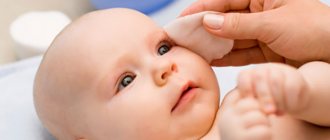February 12, 2019
Averyanova Sveta
The navel in newborns is an extremely vulnerable place in the first weeks after birth. An unhealed wound can become a gateway to infection. Ideally, the navel heals quickly, and a neat depression, an ovary, forms on the tummy. But in four out of five babies, the navel does not retract, but remains convex. This symptom should alert parents. In our article we will talk about why a child’s navel sticks out, how to deal with the defect at home, and when you need to see a doctor urgently.
Causes of umbilical hernia in children
- Hereditary weakness of the muscles of the anterior wall of the peritoneum. If at least one of the parents had this disease, then the risk for the child increases to 70%.
- Protrusion of intestinal loops, which easily “go” inside with slight pressure.
- Hypotrophy and rickets, as a result of which muscle tone decreases.
- Prematurity. Source: https://www.ncbi.nlm.nih.gov/pubmed/29083740 Troullioud Lucas AG, Jaafar S, Mendez MD Pediatric Umbilical Hernia // StatPearls [Internet]. Treasure Island (FL): StatPearls Publishing; 2019-. 2019 Jul 5
How to determine the presence of pathologies
Feces for carbohydrates in an infant - interpretation of the analysis, normal values
A child's navel sticks out most often in the presence of a hernia; less often, a fistula is observed in newborns.
An umbilical hernia can be recognized by the following signs:
- The protrusion increases if the baby pushes. It is more visible when the child is standing;
- There may be part of the intestine in the hernial sac, then during palpation you can feel rumbling. With a large hernia, movement of the intestinal loops is noticeable;
- The abdominal muscles separate.
Hernia
Only a surgeon can accurately diagnose the pathology after examination.
If a child has a fistula, the following symptoms are observed:
- Inflammation of the umbilical ring;
- There is a visible wound in the navel, which goes deep into the abdomen. It persists even when the baby is 4 weeks old, gets wet, and the crust does not form;
- The baby's tummy smells unpleasant;
- Bloody, purulent discharge is observed. Yellowish fluid accumulates in the navel, and the baby's bowel movements may be noticeable;
- The belly button sticks out when the baby starts to cry or cough.
Signs are determined by the severity of the disease. If your baby has a fever, he urgently needs medical attention.
Features of the disease in children
Normally, the abdominal wall consists of the dermis, subcutaneous fat, aponeurosis, and peritoneum. Muscles and aponeurosis are load-bearing layers, and the likelihood of a hernia depends on them.
A predisposition to the disease is the presence of a weak zone in the aponeurotic-muscular layer. The elastic peritoneum protrudes under the influence of internal pressure. Increasing over time (this may take several months), the hernia moves under the skin, a visually noticeable protrusion is formed, which is easily palpated. Source: M.A. Zvorygina, A.F. Khafizova, S.N. Styazhkina Hernias of the anterior abdominal wall // Questions of science and education, 2021, pp. 62-66
The structure of the umbilical hernia:
- internal tissues (“hernial sac”);
- intestinal loops and other organs located in the “hernial sac” (“hernial contents”);
- a vulnerable spot in the peritoneum through which the hernia penetrates outward (“hernial orifice”).
This disease often heals itself; it is not characterized by infringement. Therefore, parents often prefer to just wait and not take any action. However, the disease, although it does not cause pain, can lead to bloating, leading to increased restlessness in the child. Also, children with this disease often become weather sensitive.
Possible reasons
If the umbilical ring is dilated in a newborn, then parents wonder why their child has such a condition.
The reasons may vary. The enlargement of the umbilical ring usually results from the following:
- weakness of the connective tissue located in the navel area;
- muscle hypotonicity;
- tissue changes under the influence of the inflammatory process;
- individual feature.
The expansion of the umbilical ring in a baby may be due to a difficult pregnancy or poor heredity.
Various diseases can lead to a decrease in tissue turgor and muscle tone. If the umbilical ring is dilated in a newborn, you should consult a doctor. Only a specialist can determine the cause of this condition. Typically, any abnormalities are detected in the first 1-4 weeks of a child’s life.
Most often, navel expansion is observed in premature babies. This is explained by the fact that their umbilical ring closes more slowly than required.
Symptoms and treatments
Signs of an umbilical hernia in children
Every fifth child is susceptible to the disease (among premature babies - every third). Moreover, various pathologies of the umbilical ring are diagnosed in almost everyone at birth.
An external manifestation is the presence of a hernial protrusion , which is constantly visible or appears only when crying. The navel may protrude by 1-2 cm, but this is not always a pathology, but may simply be a feature of the anatomy. The protrusion can be in the form of a circle or oval, it can be easily reduced. Often, weakness of the anterior part of the peritoneum, along with a hernia, provokes divergence of the rectus abdominis muscles.
Although a hernia in the umbilical area is a disease of newborns, it can also appear at a later age - when they begin to walk. The reason in this case is too early verticalization.
Why do babies have a protruding belly button?
Frequent urination in a child under one year old - possible causes
A protruding navel may not bother the baby in any way, but it can also cause unpleasant symptoms that can only be removed through surgery.
Natural causes
It happens that the umbilical cord is cut high, leaving it too long, because of this the navel remains convex. Then it is considered that this is a characteristic of the child. However, even in this case, it can cause inconvenience if the navel rubs against the diaper or clothes, which leads to irritation and redness of the skin.
Hernia
The most common explanation for a baby's belly button protruding is a hernia. Usually it is congenital and becomes noticeable in the second month of the baby’s life. Normally, after cutting the umbilical cord, the umbilical ring tightens and contracts. If this does not happen, or it does not close completely, a protrusion is formed. It is especially noticeable when the child cries or coughs. Any tension in the abdominal muscles indicates a hernia. Moreover, in the normal state, when the baby is lying down, he is calm, she may not give herself away.
The formation of a hernia is associated with muscle immaturity and delayed development of the child in the womb. Usually it can be removed by pressing, but setting it yourself is not recommended. Any deviations should be observed by a doctor, and action must be taken based on his prescriptions and advice.
Surgeon's baby
Note! There is no need to think that the baby’s crying and coughing provoke the formation of a hernia. They can only intensify its manifestation and are incapable of becoming the root cause of the disease.
Umbilical fistula
It happens that during fetal development the vitelline and urinary ducts remain open or close, but not completely. Then a small hole remains in the navel, which goes to the internal organs. If the child’s urine and feces are released through it, they speak of a complete fistula, which must be treated urgently and only surgically.
The ducts often do not have time to close in premature babies. In healthy babies born at term, they should close completely. It happens that a fistula becomes an acquired pathology, this can happen under the influence of the following factors:
- Pinched hernia;
- Intestinal injuries;
- Incorrect actions of medical personnel when cutting the umbilical cord.
More about treatment
If an umbilical hernia appears immediately at birth, it can be removed by six months. To do this, you need to take a number of conservative measures.
- Place the baby on his stomach twice or thrice a day 15 minutes before feeding on something solid.
- Massage the baby's legs, arms and back while laying down - small strokes that should be carried out from bottom to top.
- Abdominal massage (a method of not only treatment, but also prevention). It is prescribed by a pediatrician, and he also provides instructions for parents. Massage can also be performed by a professional in a clinic.
- Applying a plaster bandage to the hernia as recommended by a pediatrician or surgeon.
- Applying a patch to the area near the navel.
Surgical intervention is carried out if the above measures do not produce results, and the hernia does not self-heal with age. The defect can be corrected surgically before five years if the hernia is too large.
The operation consists of eliminating the excessive size of the umbilical ring. It is performed through a small incision above the navel in a natural fold of skin. Thanks to this technique, a good cosmetic effect is achieved - the scar is almost invisible. Source: https://www.ncbi.nlm.nih.gov/pubmed/15329986 Fassiadis N, Theodorides A, South LM Novel technique of small umbilical hernia repair in children / / Ann R Coll Surg Engl. 2004 Jul;86(4):305-6
Effective massage
Massage is particularly effective; you can watch the video on how to do it. All movements should be light and without physical exertion. Pressure can be done as follows:
- clockwise and counterclockwise;
- along the oblique muscles.
The movements can be supplemented by rubbing the surface of the abdomen and pinching around the umbilical ring. In this case, you need to perform soothing strokes. Children's massage should be done in any case, regardless of illness. 4 weeks after birth, when the umbilical wound has healed, you can begin the necessary treatment. Massage should be done in the absence of inflammatory processes in the abdominal area. Here are some rules for its implementation:
- The procedure should be carried out in a warm room.
- Massage should begin half an hour before feeding.
- Up to two procedures can be performed per day.
- Only a specialist or parents who have been trained can perform the procedure.
- The baby should only be placed on hard surfaces.
Here is an option for children under three years old:
- First, stroking movements are performed clockwise up to 7 times.
- Massage from the navel to the sides along the oblique muscles with light pressure.
- Stroking from top to bottom. Do 5 reps.
- Rubbing the muscles from the sides towards the navel.
- Pressing the index finger around the navel.
- Circular movements around the bulge.
With such movements, the muscles contract and the tissue around the umbilical area strengthens. In addition, you can do bicycle exercises, swinging on a ball and squats. After two years of age, a hernia usually appears as a result of coughing, muscle wasting, and constipation. In this case, it is recommended to go with the child to the pool, attend physiotherapeutic procedures and get a massage.
Preventive measures
First of all, parents should take care that the child does not strain too much, and also ensure the prevention of bloating, that is, constipation and increased gas formation.
The most favorable factor that has a positive effect on the digestive processes and general condition of the baby is breastfeeding. In this case, the mother needs to adhere to a diet, that is, exclude legumes, cabbage, sausages, sweets, etc. from the diet. The baby’s well-being will be best affected if the mother eats a lot of fruits, bran, fresh vegetables, fermented milk and whole grain products, as well as 3 -5 dried apricots or prunes per day to prevent constipation in babies.
If for objective reasons artificial feeding is necessary, then the mixture should be prescribed only by a pediatrician, taking into account the characteristics of the body, to prevent allergies, colic, constipation and bloating. The doctor can also prescribe medications that are safe for the child to normalize digestion and prevent constipation if the mother has violated the diet, the child is not suitable for artificial nutrition, or gastrointestinal diseases are detected.
Early age is also characterized by frequent dysbiosis, which causes constipation and bloating. First of all, in this case, the symptoms are eliminated, and then the underlying disease.
Lactose intolerance is often detected in infants. As a result, breast milk is not digested, but ferments in the intestines, causing bloating and a number of other unpleasant symptoms. To eliminate symptoms, it is necessary to select artificial nutrition.
What to do if the umbilical ring is hypotonic?
The first thing parents who notice an enlarged navel in their child need to do is show it to the pediatrician. You may need to undergo testing to determine the cause of this condition. It is important to make every effort to prevent a hernia from occurring. To do this, it is necessary to strengthen the muscles of the abdominal wall.
For hypotonicity of the umbilical ring, the following measures are effective:
- conducting a massage course . Manual therapy helps normalize blood circulation and strengthen the abdominal muscles. The massage must be performed competently and very carefully so as not to harm the baby. Therefore, it is better to contact experienced specialists. The following techniques are usually used: stroking, pressing, plucking movements;
- use of supportive measures. Such devices include bandages and plasters. They are used for severe expansion of the umbilical ring. They have a supporting and pressing effect. The patch is an inexpensive means of preventing pinching of internal organs. It is better to use it under the supervision of a doctor. In some cases, the patch causes irritation of the epidermis. The bandage is designed for long-term wear. It looks like an elastic belt with a stopper pad. Does not cause skin irritation;
- using strengthening poses . The method of laying the crumbs on the stomach is used. This method helps prevent the development of a hernia and eliminate minor disturbances in the abdominal cavity. Before each feeding, you should place the baby on his stomach. A minute of staying in this position is quite enough to prevent dangerous conditions. This method is especially recommended for children who are predisposed to developing a hernia;
- carrying out physical therapy . Special exercises are used that strengthen the muscles of the abdominal wall and improve blood circulation. Newborns have limited physical capabilities. Therefore, the gymnastics complex is small for them. Positive changes can be achieved through systematic training.
Umbilical patch
If a child develops a hernia and conservative treatment methods do not give the desired result, then he undergoes surgery. Surgical intervention is indicated from the age of three. Through the incision, the doctor releases the pinched area and sets the organs. Then stitches are applied.
This method in most cases successfully solves the problem of umbilical hernia. Komarovsky notes that expansion of the umbilical ring is a fairly common problem among infants. It can be eliminated through an integrated approach.
Surgical department "SM-Clinic"
We employ some of the best surgeons and other pediatric specialists in the city. We will promptly diagnose an umbilical hernia in your baby, give the necessary recommendations or correct the defect surgically. Our clinic is equipped with advanced equipment and has a convenient hospital where children feel comfortable and pleasant.
Call us to make an appointment or ask any questions.
Sources:
- https://www.ncbi.nlm.nih.gov/pubmed/29083740 Troullioud Lucas AG, Jaafar S, Mendez MD. Pediatric Umbilical Hernia // StatPearls [Internet]. Treasure Island (FL): StatPearls Publishing; 2019-. 2019 Jul 5.
- M.A. Zvorygina, A.F. Khafizova, S.N. Styazhkina. Hernia of the anterior abdominal wall // Questions of science and education, 2021, pp. 62-66.
- https://www.ncbi.nlm.nih.gov/pubmed/15329986 Fassiadis N, Theodorides A, South LM. Novel technique of small umbilical hernia repair in children // Ann R Coll Surg Engl. 2004 Jul;86(4):305-6.
Grebenyuk Mikhail Viktorovich Clinic
Author of the article
Grebenyuk Mikhail Viktorovich
Specialty: surgeon
Experience: 18 years
The information in this article is provided for reference purposes and does not replace advice from a qualified professional. Don't self-medicate! At the first signs of illness, you should consult a doctor.
Traditional methods
Sometimes treatment with folk remedies is also used. For example, our grandmothers used a conspiracy. Our ancestors believed that this disorder occurs in a child due to the influence of evil forces.
The technology is like this:
After giving birth to children, the mother should slightly squeeze the bulge in her tummy and say the following words: “Disease, I am gnawing at you, you have only one fang, and I have all 7, I will remove you.” The plot should be read three times.
Whether you believe such methods or not is up to you, but I prefer to consult a specialist.
Prices
| Name of service (price list incomplete) | Price |
| Appointment (examination, consultation) with a pediatric surgeon, primary, therapeutic and diagnostic, outpatient | 1750 rub. |
| Consultation (interpretation) with analyzes from third parties | 2250 rub. |
| Prescription of treatment regimen (for up to 1 month) | 1800 rub. |
| Prescription of treatment regimen (for a period of 1 month) | 2700 rub. |
| Consultation with a candidate of medical sciences | 2500 rub. |
| Hernia repair of umbilical hernia/hernia of the white line of the abdomen, category I. difficulties | 33,000 rub. |
| Removal of condylomas, category I. difficulties | 3550 rub. |
| Removal of condylomas, category II. difficulties | 8900 rub. |
| Excision/removal of benign formations of the skin and mucous membrane, category I. difficulties | 2550 rub. |
Rules for treating umbilical wounds
The risk of developing complications associated with the healing process of the umbilical wound is reduced if it is properly cared for. Before performing any manipulations, you must wash your hands thoroughly. A little hydrogen peroxide should be dropped onto the wound, after which a foam will form on the skin. All excess must be carefully removed using a cotton swab. If the wound is not completely cleaned at one time, you can reuse peroxide.
After completing hygiene procedures, you need to carefully examine the surface of the navel for the presence of pus or any suspicious discharge. After the completed manipulations, it is recommended to wipe the navel with a dry cotton swab.
To ensure that caring for a newborn’s navel does not harm, you must follow simple rules:
- To treat the umbilical wound, you should not use iodine or a solution of potassium permanganate. They can cause skin burns.
- There is no need to put a gauze bandage on the navel or cover it with a band-aid.
- Until the wound on the stomach has healed, it is recommended to bathe the child in boiled water.
Until the navel heals, it is recommended to use special diapers with a cutout on the belly for the newborn. This will prevent skin irritation and speed up the wound healing process.










